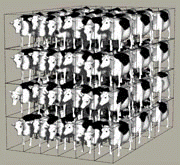Animal Science, Department of

World Congress on Genetics Applied to Livestock Production: 3rd (1986)
Date of this Version
1986
Abstract
Genetic engineering requires clearly defined objectives, adequate genetic variability and effective methods of selection. In a given production-marketing System, relative importance of genetic change in alternative traits can be estimated from expected effects on cost per unit of output, using available biological and economic information. Diversity among existing breeds and their crosses is a primary and quickly usable genetic resource, and its management for future needs is a public concern. Better physiological and biochemical understanding of the genetic controls of animal development and function is important to permit more effective selection for efficiency of animal production under diverse environments. Long-term selection experiments indicate gene numbers, limits of response, the role of natural mutations and pleiotropic associations among traits. New reproductive technology permits more intense selection among females and promises effective new nuclear breeding systems. New techniques for manipulating bits of DNA also stimulate many questions about potential applications in animal breeding. All of the above, provide background for critical evaluation of industry breeding programs, which also involves educational and organizational efforts. Contributions from all specialties within the animal breeding fraternity, as well as from our colleagues in related disciplines, are needed for continued progress in livestock improvement.


Comments
Published in 3rd World Congress on Genetics Applied to Livestock Production, edited by Gordon E. Dickerson and Rodger K. Johnson, 4 vols. (Lincoln: University of Nebraska Institute of Agriculture and Natural Resources, 1986). Copyright © 1986 Board of Regents University of Nebraska.